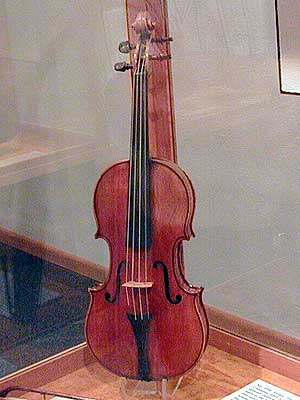|
Audio
Photos
Resources
Respond to this story
|
Modern technology helps solve instrument mysteries
December 11, 2002
 |
| This violin was made in 1693 by Antonio Stradivari. It's known as the Harrison -- named after one of its owners. (MPR Photo/Cara Hetland) |
Sioux Falls, S.D. — Each violin has a personality of its own -- its own sound, its own feel. Some musicians say the older the violin, the better it is.
The National Music Museum in Vermillion, South Dakota, serves as a research facility of sorts for old instruments. The museum has 10,000 instruments in its collection, and 750 of them are on display. Each instrument has its own history.
Andre Larson, the museum's director, stands at a glass case in the back of the great stringed instrument room. He points to a violin made in 1693 by Antonio Stradivari. The violin is known as the Harrison.
 | |||
"Harrison was an English solicitor who owned the instrument in the 19th century, at a time many gentlemen played string quartet on Sunday afternoons to entertain themselves in homes," Larson says.
The Harrison was played, and its music recorded, in April 2002. Larson believes these instruments should be played once every generation, or about every 25 years.
The Harrison is one of a few 17th century Strads with its original neck. Many of those instruments were modernized. The neck was tilted to accommodate the tension of metal strings for a fuller sound. Often the original neck was thrown away. But on the Harrison, the neck was modified with a small piece of wood.
This summer about 50 instruments from the National Music Museum were taken to a hospital in Vermillion. The instruments were carefully held above a CT table to be scanned.
 | |||
Violin maker John Waddle will analyze the scans. CT scans measure density. Waddle says scans show him detail he wouldn't be able to see unless he took an instrument apart. He can see the grains of a spruce, glue lines and patches. Modern technology allows him to see how an instrument was made.
"They might be thicker on one side than they are on the other, and that was kind of a surprise. We were taught in violin making school to make them very symmetrical, very careful thicknesses and graduations," says Waddle. "We're studying now, as we gather more data, is there some kind of pattern to this -- a symmetry -- or could it have been accidental? Were they just in a hurry or did they do this on purpose? Maybe that's one of the questions we'll be able to answer."
Waddle is hoping to answer other questions. He'd like to solve the age-old question of what kind of varnish Antonio Stradivari used. Many say this is the secret to the great sound. One theory is that he boiled the wood in shrimp shells. Waddle says there are other theories as well.
 | |||
"He baked it, or he used some kind of wood from some species of tree that no longer exists. They just go on and on and on and a lot of them are just really ridiculous," says Waddle. "I think we'll be able to show that some of them just aren't true. And we might also be able to show that, really, the differences between a Strad and some of the best modern instruments aren't there -- they really aren't that different. There are some really awfully good instruments being made."
Waddle says it'll take months before he's analyzed all of the scans -- and when he's finished he'll compile the data and give it to the National Music Museum. The information from the scans will be added to other research done on the instruments.
John Waddle says this is a labor-intensive project, but not an expensive one. The Vermillion hospital provided the scans at no charge. Waddle is not being paid for his efforts. He says it's a different time for violin makers. Unlike the secrets of the past, today they share everything.
|
News Headlines
|
Related Subjects
|
